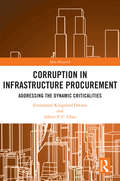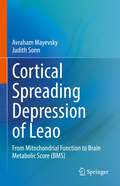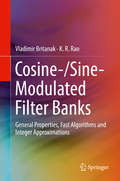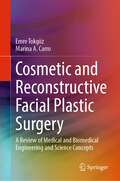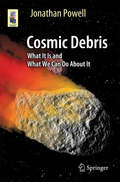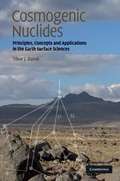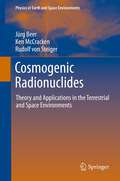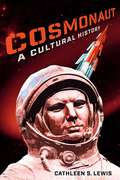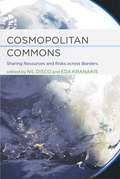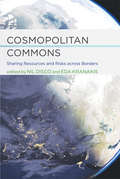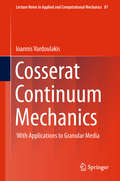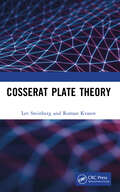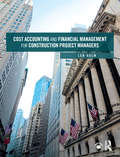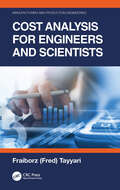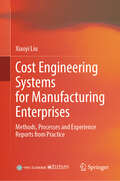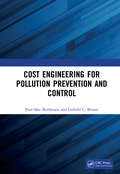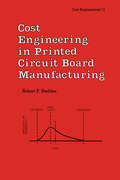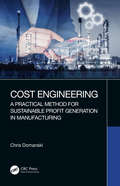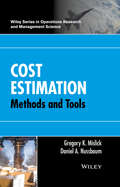- Table View
- List View
Corruption Networks: Concepts and Applications (Understanding Complex Systems)
by Oscar M. Granados José R. Nicolás-CarlockThis book aims to gather the insight of leading experts on corruption and anti-corruption studies working at the scientific frontier of this phenomenon using the multidisciplinary tools of data and network science, in order to present current theoretical, empirical, and operational efforts being performed in order to curb this problem. The research results strengthen the importance of evidence-based approaches in the fight against corruption in all its forms, and foster the discussion about the best ways to convert the obtained knowledge into public policy.The contributed chapters provide comprehensive and multidisciplinary approaches to handle the non-trivial structural and dynamical aspects that characterize the modern social, economic, political and technological systems where corruption takes place.This book will serve a broad multi-disciplinary audience from natural to social scientists, applied mathematicians, including law and policymakers.
Corruption in Infrastructure Procurement: Addressing the Dynamic Criticalities (Spon Research)
by Albert P.C. Chan Emmanuel Kingsford OwusuThis book presents an extensive study on the extant constructs of corruption in infrastructure-related projects and aims to contribute to the determination and elimination of its incidence and prevalence in infrastructure projects. The book conducts a comprehensive examination of the various determining factors of corruption that negatively affect the procurement process and, in the end, result in cost and time overruns. The authors present an in-depth understanding of how the identified determining factors of corruption can be addressed. Thus, it is intended to broaden the reader's knowledge of the causes, risk indicators, and different forms of corrupt practices in the procurement process of infrastructure works, before explaining how they affect its stages and activities A dynamic model is developed to demonstrate how to tackle the overall impact of corruption within the procurement process and, at the same time, increase the effectiveness of the extant anti-corruption measures. In short, this book demonstrates that the fight against corruption in the procurement process is strategically feasible and must continue. This book is essential reading for academics, researchers, professionals and stakeholders in the procurement of infrastructure projects and civil works, as well as those with an interest in corruption, construction management and construction project management.
Cortical Spreading Depression of Leao: From Mitochondrial Function to Brain Metabolic Score (BMS)
by Avraham Mayevsky Judith SonnThis book focuses on energy metabolism and brain functions related to Cortical Spreading Depression of Leao (CSD), an important issue in brain pathophysiology. The first part of the book offers a comprehensive overview of the history and early research on CSD, and then discusses the recent advances in the technology used to map and monitor brain mitochondrial NADH redox state and other physiological functions during CSD. The chapters explore the connection between CSD and mitochondrial function under hypoxia, Ischemia and various drugs treatment, and provide a resource to scientists researching the development of CSD during various brain pathophysiological conditions. This book is essential to scientists and students working in the field of bioenergetics of the brain and various organs and tissues in the body. The use of this technology is also crucial and applicable in the neuroscience field.
Cosine-/Sine-Modulated Filter Banks: General Properties, Fast Algorithms and Integer Approximations
by K. R. Rao Vladimir BritanakThis book covers various algorithmic developments in the perfect reconstruction cosine/sine-modulated filter banks (TDAC-MDCT/MDST or MLT, MCLT, low delay MDCT, complex exponential/cosine/sine-modulated QMF filter banks), and near-perfect reconstruction QMF banks (pseudo-QMF banks) in detail, including their general mathematical properties, matrix representations, fast algorithms and various methods to integer approximations being recently a new transform technology for lossless audio coding. Each chapter will contain a number of examples and will conclude with problems and exercises. The book reflects the research efforts/activities and achieved results of the authors in the time period over the last 20 years.
Cosmetic and Reconstructive Facial Plastic Surgery: A Review of Medical and Biomedical Engineering and Science Concepts
by Emre Tokgöz Marina A. CarroCosmetic and Reconstructive Facial Plastic Surgery: Medical and Biomedical Engineering and Science Concepts provides an extensive overview of the most recent technological advancements in facial plastic and reconstructive surgeries and head and neck surgery through a thorough review of the literature in biomedical engineering, technology, and medicine. Coverage includes the most recent engineering and computing techniques, such as robotics, biomechanics, artificial intelligence (AI), deep learning (DL), machine learning (ML), and optimization, as well as the medical and surgical aspects of medical and scientific methods, surgical and non-surgical procedure types, complications, patient care, and psychological factors. This book will be a valuable introduction to concepts and advances for otorhinolaryngology, biomedical researchers, academics, and students.
Cosmic Debris: What It Is and What We Can Do About It (Astronomers' Universe)
by Jonathan PowellThis book examines the mysterious and the well-studied debris in Earth's crowded neighborhood. From orbiting comets to the workings of the Asteroid Belt, and from meteor showers to our home-grown network of orbiting satellites, the full diversity of space objects and the debris they create is explored. Powell also discusses some of the current research techniques used to find potentially harmful rogue elements, with an emphasis on keeping watch for any objects that may intersect Earth's orbit. Such bodies also impact other worlds, and much has been learned from observing these encounters. The information in this book is intended to foster thought about the universe in which we live, but without overloading its readers with numbers and lecture-room analysis. Like a good thriller, it allows its readers to pace themselves with the story and, by the end, encourages them to draw their own conclusions.
Cosmic Ray Neutron Sensing: Estimation of Agricultural Crop Biomass Water Equivalent
by Ammar Wahbi Lee Heng Gerd DerconThis open access book provides methods for the estimation of Biomass Water Equivalent (BEW), an essential step for improving the accuracy of area-wide soil moisture by cosmic-ray neutron sensors (CRNS). Three techniques are explained in detail: (i) traditional in-situ destructive sampling, (ii) satellite based remote sensing of plant surfaces, and (iii) biomass estimation via the use of the CRNS itself. The advantages and disadvantages of each method are discussed along with step by step instructions on proper procedures and implementation.
Cosmogenic Nuclides
by Tibor J. DunaiThis is the first book to provide a comprehensive and state-of-the-art introduction to the novel and fast-evolving topic of in-situ produced cosmogenic nuclides. It presents an accessible introduction to the theoretical foundations, with explanations of relevant concepts starting at a basic level and building in sophistication. It incorporates, and draws on, methodological discussions and advances achieved within the international CRONUS (Cosmic-Ray Produced Nuclide Systematics) networks. Practical aspects such as sampling, analytical methods and data-interpretation are discussed in detail and an essential sampling checklist is provided. The full range of cosmogenic isotopes is covered and a wide spectrum of in-situ applications are described and illustrated with specific and generic examples of exposure dating, burial dating, erosion and uplift rates and process model verification. Graduate students and experienced practitioners will find this book a vital source of information on the background concepts and practical applications in geomorphology, geography, soil-science, and geology.
Cosmogenic Radionuclides: Theory and Applications in the Terrestrial and Space Environments (Physics of Earth and Space Environments)
by Jürg Beer Ken Mccracken Rudolf Von SteigerCosmogenic radionuclides are radioactive isotopes which are produced by natural processes and distributed within the Earth system. With a holistic view of the environment the authors show in this book how cosmogenic radionuclides can be used to trace and to reconstruct the history of a large variety of processes. They discuss the way in which cosmogenic radionuclides can assist in the quantification of complex processes in the present-day environment. The book aims to demonstrate to the reader the strength of analytic tools based on cosmogenic radionuclides, their contribution to almost any field of modern science, and how these tools may assist in the solution of many present and future problems that we face here on Earth. The book provides a comprehensive discussion of the basic principles behind the applications of cosmogenic (and other) radionuclides as environmental tracers and dating tools. The second section of the book discusses in some detail the production of radionuclides by cosmic radiation, their transport and distribution in the atmosphere and the hydrosphere, their storage in natural archives, and how they are measured. The third section of the book presents a number of examples selected to illustrate typical tracer and dating applications in a number of different spheres (atmosphere, hydrosphere, geosphere, biosphere, solar physics and astronomy). At the same time the authors have outlined the limitations of the use of cosmogenic radionuclides. Written on a level understandable by graduate students without specialist skills in physics or mathematics, the book addresses a wide audience, ranging from archaeology, biophysics, and geophysics, to atmospheric physics, hydrology, astrophysics and space science.
Cosmonaut: A Cultural History
by Cathleen S. LewisHow the public image of the Soviet cosmonaut was designed and reimagined over time In this book, Cathleen Lewis discusses how the public image of the Soviet cosmonaut developed beginning in the 1950s and the ways this icon has been reinterpreted throughout the years and in contemporary Russia. Compiling material and cultural representations of the cosmonaut program, Lewis provides a new perspective on the story of Soviet spaceflight, highlighting how the government has celebrated figures such as Yuri Gagarin and Valentina Tereshkova through newspapers, radio, parades, monuments, museums, films, and even postage stamps and lapel pins. Lewis’s analysis shows that during the Space Race, Nikita Khrushchev mobilized cosmonaut stories and images to symbolize the forward-looking Soviet state and distract from the costs of the Cold War. Public perceptions shifted after the first Soviet spaceflight fatality and failure to reach the Moon, yet cosmonaut imagery was still effective propaganda, evolving through the USSR’s collapse in 1991 and seen today in Vladimir Putin’s government cooperation for a film on the 1985 rescue of the Salyut 7 space station. Looking closely at the process through which Russians continue to reexamine their past, Lewis argues that the cultural memory of spaceflight remains especially potent among other collective Soviet memories.
Cosmopolitan Commons
by Nil Disco Eda KranakisWith the advent of modernity, the sharing of resources and infrastructures rapidly expanded beyond local communities into regional, national, and even transnational space -- nowhere as visibly as in Europe, with its small-scale political divisions. This volume views these shared resource spaces as the seedbeds of a new generation of technology-rich bureaucratic and transnational commons. Drawing on the theory of cosmopolitanism, which seeks to model the dynamics of an increasingly interdependent world, and on the tradition of commons scholarship inspired by the late Elinor Ostrom, the book develops a new theory of "cosmopolitan commons" that provides a framework for merging the study of technology with such issues as risk, moral order, and sustainability at levels beyond the nation-state. After laying out the theoretical framework, the book presents case studies that explore the empirical nuances: airspace as transport commons, radio broadcasting, hydropower, weather forecasting and genetic diversity as information commons, transboundary air pollution, and two "capstone" studies of interlinked, temporally layered commons: one on overlapping commons within the North Sea for freight, fishing, and fossil fuels; and one on commons for transport, salmon fishing, and clean water in the Rhine. Contributors: Hakon With Andersen, Nil Disco, Paul N. Edwards, Arne Kaijser, Eda Kranakis, Kristiina Korjonen-Kuusipuro, Tiago Saraiva, Nina WormbsThe hardcover edition does not include a dust jacket.
Cosmopolitan Commons: Sharing Resources and Risks across Borders (Infrastructures)
by Nil Disco Eda KranakisA new approach in commons theory to understand the interactions of technology, society, and nature, supported by case studies of new transnational European commons.With the advent of modernity, the sharing of resources and infrastructures rapidly expanded beyond local communities into regional, national, and even transnational space—nowhere as visibly as in Europe, with its small-scale political divisions. This volume views these shared resource spaces as the seedbeds of a new generation of technology-rich bureaucratic and transnational commons. Drawing on the theory of cosmopolitanism, which seeks to model the dynamics of an increasingly interdependent world, and on the tradition of commons scholarship inspired by the late Elinor Ostrom, the book develops a new theory of “cosmopolitan commons” that provides a framework for merging the study of technology with such issues as risk, moral order, and sustainability at levels beyond the nation-state. After laying out the theoretical framework, the book presents case studies that explore the empirical nuances: airspace as transport commons, radio broadcasting, hydropower, weather forecasting and genetic diversity as information commons, transboundary air pollution, and two “capstone” studies of interlinked, temporally layered commons: one on overlapping commons within the North Sea for freight, fishing, and fossil fuels; and one on commons for transport, salmon fishing, and clean water in the Rhine.ContributorsHåkon With Andersen, Nil Disco, Paul N. Edwards, Arne Kaijser, Eda Kranakis, Kristiina Korjonen-Kuusipuro, Tiago Saraiva, Nina Wormbs
Cosserat Continuum Mechanics: With Applications To Granular Media (Lecture Notes in Applied and Computational Mechanics #87)
by Ioannis VardoulakisThis textbook explores the theory of Cosserat continuum mechanics, and covers fundamental tools, general laws and major models, as well as applications to the mechanics of granular media. While classical continuum mechanics is based on the axiom that the stress tensor is symmetric, theories such as that expressed in the seminal work of the brothers Eugène and François Cosserat are characterized by a non-symmetric stress tensor. The use of von Mises motor mechanics is introduced, for the compact mathematical description of the mechanics and statics of Cosserat continua, as the Cosserat continuum is a manifold of oriented “rigid particles” with 3 dofs of displacement and 3 dofs of rotation, rather than a manifold of points with 3 dofs of displacement. Here, the analysis is restricted to infinitesimal particle displacements and rotations. This book is intended as a valuable supplement to standard Continuum Mechanics courses, and graduate students as well as researchers in mechanics and applied mathematics will benefit from its self-contained text, which is enriched by numerous examples and exercises.
Cosserat Plate Theory
by Lev Steinberg Roman KvasovThis book presents the foundation and validation of the Cosserat Plate Theory, numerical experiments of deformation and vibration, and the unique properties of the Cosserat plates. Our approach incorporates the high accuracy assumptions of the Cosserat plate deformation consistent with the Cosserat Elasticity equilibrium equations, constitutive formulas, strain-displacement and torsion-microrotation relations. The Cosserat Plate Theory is parametric, where the "splitting parameter" minimizes the Cosserat plate energy. The validation of the theory is based on the comparison with the three-dimensional Cosserat Elastostatics and Elastodynamics. The numerical results are obtained using the Finite Element Method (FEM) specifically developed to solve the parametric system of equations. The analysis of deformation of a variety of Cosserat plates shows the stress concentration reduction, higher stiffness of Cosserat plates, and the size-effect related to the microstructure. The analysis of vibration of Cosserat plates predicts size-related properties of the plate vibration, the existence of the additional so-called Cosserat plate resonances, and the dynamic anisotropy, related to the dependency of the resonances on the microelement's shapes and orientations.
Cost Accounting and Financial Management for Construction Project Managers
by Len HolmProper cost accounting and financial management are essential elements of any successful construction job, and therefore make up essential skills for construction project managers and project engineers. Many textbooks on the market focus on the theoretical principles of accounting and finance required for head office staff like the chief financial officer (CFO) of a construction firm. This book's unique practical approach focuses on the activities of the construction management team, including the project manager, superintendent, project engineer, and jobsite cost engineers and cost accountants. In short, this book provides a seamless connection between cost accounting and construction project management from the construction management practitioner’s perspective. Following a complete accounting cycle, from the original estimate through cost controls to financial close-out, the book makes use of one commercial construction project case study throughout. It covers key topics like financial statements, ratios, cost control, earned value, equipment depreciation, cash flow, and pay requests. But unlike other texts, this book also covers additional financial responsibilities such as cost estimates, change orders, and project close-out. Also included are more advanced accounting and financial topics such as supply chain management, activity-based accounting, lean construction techniques, taxes, and the developer’s pro forma. Each chapter contains review questions and applied exercises and the book is supplemented with an eResource with instructor manual, estimates and schedules, further cases and figures from the book. This textbook is ideal for use in all cost accounting and financial management classes on both undergraduate and graduate level construction management or construction engineering programs.
Cost Analysis for Engineers and Scientists (Manufacturing and Production Engineering)
by Fariborz TayyariThis book helps apply managerial accounting techniques to problems in areas including that of cost estimation, cost control, product pricing, and business segment discontinuation. It is a valuable resource for short-term courses and seminars conducted to train professionals and practitioners in engineering and manufacturing cost analysis. Cost Analysis for Engineers and Scientists introduces the fundamentals accounting information systems and manufacturing costs. It also presents product costing and manufacturing cost allocation to individual as well as joint products. The concepts and applications of cost-volume-profit and breakeven analysis for single-product and multiple-products are also discussed. It is intended for engineers, managers, and scientists to apply cost analysis techniques for assessing engineering and financial projects. A solutions manual and PowerPoint slides are available for qualified textbook adoption.
Cost Effectiveness Modelling for Health Technology Assessment: A Practical Course
by Peter Hall Richard Edlin Christopher Mccabe Claire Hulme Judy WrightThis book provides an introduction to decision analytic cost-effectiveness modelling, giving the theoretical and practical knowledge required to design and implement analyses that meet the methodological standards of health technology assessment organisations. The book guides you through building a decision tree and Markov model and, importantly, shows how the results of cost-effectiveness analyses are interpreted. Given the complex nature of cost-effectiveness modelling and the often unfamiliar language that runs alongside it, we wanted to make this book as accessible as possible whilst still providing a comprehensive, in-depth, practical guide that reflects the state of the art - that includes the most recent developments in cost-effectiveness modelling. Although the nature of cost effectiveness modelling means that some parts are inevitably quite technical, across the 13 chapters we have broken down explanations of theory and methods into bite-sized pieces that you can work through at your own pace; we have provided explanations of terms and methods as we use them. Importantly, the exercises and online workbooks allow you to test your skills and understanding as you go along.
Cost Engineering Systems for Manufacturing Enterprises: Methods, Processes and Experience Reports from Practice
by Xiaoyi LiuFunction, quality and cost are the three core elements of a product. Especially in the future, under the general trend of digitalisation and AI, it is a must for manufacturing companies to establish a complete cost engineering system. Based on 25 years of practical experience and method research in German and Chinese automotive companies, the author systematically introduces cost engineering system, cost engineering methods and their practical applications in the entire product process for the first time in this book, and presents a large number of practical examples of cost optimisation. Looking to the future, like the quality system standard, the cost engineering system also needs a standard for production companies. Cost analysis software, AI + cost engineering are important tools for manufacturing companies to fully and intelligently exploit the potential of cost optimisation.
Cost Engineering for Pollution Prevention and Control
by Paul Mac Berthouex Linfield C. BrownEnvironmental engineers work to increase the level of health and happiness in the world by designing, building, and operating processes and systems for water treatment, water pollution control, air pollution control, and solid waste management. These projects compete for resources with projects in medicine, transportation, education, and other fields that have a similar objective. The challenge is to make the investments efficient – to get the best project outputs with a minimum of inputs. Cost Engineering for Pollution Prevention and Control examines how to identify the best solution by judging alternatives with respect to some measure of system performance, such as total capital cost, annual cost, annual net profit, return on investment, cost-benefit ratio, net present worth, minimum production time, maximum production rate, minimum energy utilization, and so on. Key Features: Explains how to estimate preliminary costs, how to compare the life cycle costs of alternative projects, how to find the optimal balance between capital costs and operating costs. Emphasis is placed on formulating the problem rather than on the mathematical details of how the calculations are done. Provides numerous practical examples and case studies. Includes end-of-chapter exercises dealing with water, wastewater, air pollution, solid wastes, and remediation projects. The important concepts presented in this book can be understood by those students who have taken an introductory course in environmental engineering. Advanced knowledge of process design is not required. The material can also be utilized by engineers, managers, and others who would benefit from a better understanding of how engineers look at problems.
Cost Engineering in Printed Circuit Board Manufacturing
by R. P. HeddenThis book is intended as an introduction to printed circuit board manufacturing processes and terminology for readers who have no exposure to them. It provides techniques and approaches to estimating that should prove useful to all who participate in the estimating process.
Cost Engineering: A Practical Method for Sustainable Profit Generation in Manufacturing
by Chris DomanskiIn today’s hyper-competitive, global marketplace, a manufacturing company needs a competitive edge if it is to survive and grow. That edge could be anything from superior manufacturing technology to innovative product design; from patent protection to solid, well-established customer relationships. One competitive edge available to all manufacturers, but realized by only a few, is the ability to accurately measure, control, and optimize costs throughout a product’s entire life cycle. The lack of a methodology to engineer cost optimization into every product makes attaining and maintaining profitability all that the more difficult. Cost Engineering provides a means for a manufacturer to achieve and sustain profitability by designing and manufacturing products to specific cost requirements. It incorporates a variety of proven methodologies including cost estimating, cost control, and cost optimization. Features: Describes the components and organization of an effective cost optimization process Provides detailed explanations of cost estimating techniques for many of the most common manufacturing processes Explains the selection and use of appropriate cost allocation methods Presents the fundamentals of cost-based negotiation Includes both proper and improper executions of cost engineering principles The details presented in this book are important to design engineers, manufacturing engineers, buyers, accountants, cost estimators, cost optimization specialists, and their managers and provides CEOs, COOs, general managers, product line managers, and plant managers with guidance on improving and sustaining profitability. .
Cost Estimation
by Gregory K. Mislick Daniel A. NussbaumPresents an accessible approach to the cost estimation tools, concepts, and techniques needed to support analytical and cost decisions Written with an easy-to-understand approach, Cost Estimation: Methods and Tools provides comprehensive coverage of the quantitative techniques needed by professional cost estimators and for those wanting to learn about this vibrant career field. Featuring the underlying mathematical and analytical principles of cost estimation, the book focuses on the tools and methods used to predict the research and development, production, and operating and support costs for successful cost estimation in industrial, business, and manufacturing processes. The book begins with a detailed historical perspective and key terms of the cost estimating field in order to develop the necessary background prior to implementing the presented quantitative methods. The book proceeds to fundamental cost estimation methods utilized in the field of cost estimation, including working with inflation indices, regression analysis, learning curves, analogies, cost factors, and wrap rates. With a step-by-step introduction to the practicality of cost estimation and the available resources for obtaining relevant data, Cost Estimation: Methods and Tools also features: Various cost estimating tools, concepts, and techniques needed to support business decisions Multiple questions at the end of each chapter to help readers obtain a deeper understanding of the discussed methods and techniques An overview of the software used in cost estimation, as well as an introduction to the application of risk and uncertainty analysis A Foreword from Dr. Douglas A. Brook, a professor in the Graduate School of Business and Public Policy at the Naval Postgraduate School, who spent many years working in the Department of Defense acquisition environment Cost Estimation: Methods and Tools is an excellent reference for academics and practitioners in decision science, operations research, operations management, business, and systems and industrial engineering, as well as a useful guide in support of professional cost estimation training and certification courses for practitioners. The book is also appropriate for graduate-level courses in operations research, operations management, engineering economics, and manufacturing and/or production processes.
Cost Management of Capital Projects (Cost Engineering #27)
by Kurt HeinzeAiming to bridge the gap between the quantitative viewpoint of management science and the practical, day-to-day needs of project cost management, this text offers coverage of an integrated cost management programme. It presents the use of method study techniques to increase the effectiveness of procedures and improve the productivity of resources, emphasizing a systematic approach to cost control.
Cost Management of Construction Projects
by Donald ToweyThe cost manager/quantity surveyor plays a pivotal role in the financial and contract management of construction projects, although the exact nature of the service they provide depends on the project employer's terms of engagement. This can mean acting as consultant in a range of roles including cost and advisory services for budget setting to initiate a project, cost management through the design and construction phases, contract administration and acting as the client side project manager to oversee the entire building process.Cost Management of Construction Projects focusses on the cost manager/quantity surveyor engaged by the project client, and discusses key elements that help drive project success including measurement (based on the New Rules of Measurement published by RICS), procurement, cost planning, contract administration and project cost management. With examples, it provides a thorough guide to the role in the workplace and in the field, directly addressing the day to day situations faced by the cost manager/quantity surveyor.Donald Towey MRICS has extensive experience of the construction industry. His experience began as an estimator with a glass/glazing contractor in Manchester. Following a number of positions with UK contractors he relocated to Australia and has worked with a number of developers and main contractors, as well as doing freelance work. He is currently working in contracts management in Sydney.
Cost Modelling
by Martin Skitmore Vernon MarstonCost models underlie all the techniques used in construction cost and price forecasting, yet until relatively recently industry has been unfamiliar with their characteristics and properties. An understanding of the various types of cost model is vital to enable effective cost control and the development of future forecasting techniques.This volume brings together more than 20 seminal contributions to building cost modelling and introduces the major landmarks in progress and thinking in this field:* strategies and directions* explorations in cost modelling* cost-product/process modelling* dealing with uncertaintyThe strong techniques bias of this book will appeal to construction professionals involved in estimating, as well as researchers and students of building economics.

